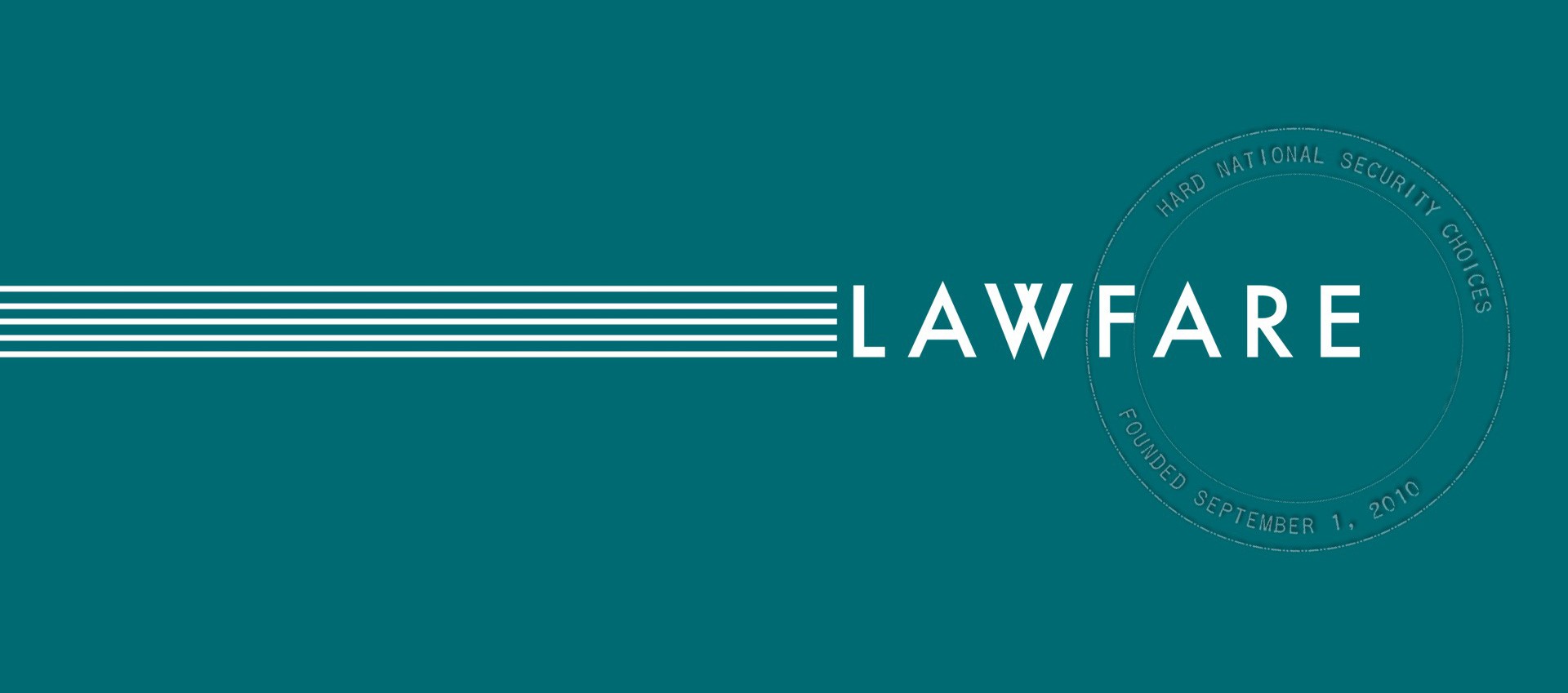The Military at Home
A review of William C. Banks and Stephen Dycus's Soldiers on the Home Front: The Domestic Role of the American Military (Harvard, 2016).
***
Published by The Lawfare Institute
in Cooperation With

A review of William C. Banks and Stephen Dycus's Soldiers on the Home Front: The Domestic Role of the American Military (Harvard, 2016).
***
Soldiers on the Home Front explores the potential threat the military poses to our civil liberties and rule of law when the military operates in our homeland. The authors expressly recognize and honor our military members for their service in securing and safeguarding our nation throughout its history and today. With numerous historical examples, the authors readily acknowledge that throughout history the military has typically respected their proper role and stayed out of the country’s civil affairs. And when the military has stepped in, it has almost always performed its unique role with distinction. But occasionally the military has intruded when not needed, almost always at the behest of overeager, even reckless, civilian leaders. When this has occurred it has invariably involved a significant loss of liberty for our society. The authors quote Antonio in Shakespeare’s Merchant of Venice to capture the contemporary relevance of their book: “what’s past is prologue.”
The book begins, after a brief introduction, with the Redcoats marching “bayonets fixed—into the City of Boston.” After setting the initial scene of the Boston Massacre, the book quickly turns even further back in time, to our English origins, to lay the foundations of our nation’s most treasured and basic concepts, such as the due process as opposed to martial law, the principal of necessity, the use and limitations of a militia, the necessity and yet wariness of establishing a standing army, the need to subordinate the military to civilian rule, as well as the struggle of power between the legislative and executive branches over control of and proper use of our military.
The chapter covering our nation’s origins provides an effective primer on how the colonists settled America and the framers crafted our Constitution. The authors efficiently demonstrate our country’s initial attempts to strike a proper balance of power that would enable the executive to effectively use the military, but with constraints. The chapter takes the reader through the sequence of events that fueled the rebellion, gave birth to our nation, and framed our Constitution. It ends by explaining the framers’ intent as to the role of the standing federal army, state militias, and the overall division of authority between the federal and state governments. From the Magna Carta through the Boston Massacre to the Philadelphia Convention, the chapter is quick and engaging. By the end, the reader has a refreshed and deepened sense of the core concepts of a representative democracy, security for our country, and individual liberty for our citizens, which form the analytical framework the authors use throughout the book.
The book is then divided into chapters explaining how our nation, throughout its history, has used the military as peacekeepers, cops, jailors, judges, investigators—even as rulers. The chapter titles alone, and certainly taken together, stir concern. Inside each chapter lies historical accounts of the most significant and relevant instances of our military being used to control our civil affairs. The chapters are packed with examples. Some examples were clearly appropriate uses of military force, others obviously not. But it is the concentration of the examples, coupled with an analysis as to how those examples fare under our laws, that makes the book so valuable.
The most extensive and legitimate use of our military in civil affairs, as demonstrated in Chapter 3, has been as Peacekeepers and Cops, categories that include the provision of disaster relief. Chapter 3 begins by fixing the general boundaries envisioned by the Framers—that the government would, at times, use the military to keep the peace and police civil society—but using the military in this fashion was to be reserved for extraordinary times, when the rule of law or the government as a whole was threatened. Yet, whether for political compromise, or intentionally building in flexibility for an unpredictable future, or both, the Framers did not provide comprehensive and unambiguous language about the military’s proper role domestically in the Constitution. Indeed, the authors describe the Framers language as “blurred” and “cryptic.”
Chapter 3 explains how the Second Congress attempted to flesh-out some of that cryptic language. Invoking its explicit power under the Constitution to “provide for calling forth the Militia to execute the Laws of the Union, suppress Insurrections and repel Invasions,” Congress passed the Calling Forth Act of 1792. It explicitly delegated to the President the power to actually call-up the Militia into federal service in times of Invasion, threat of Invasion, by foreign powers or Indian Tribes, and in times of Insurrection. The Calling Forth Act, also known as the 1792 Militia Act, was a broad and relatively unrestrained delegation of power to the President to respond to invasions and insurrections. On a much more limited basis, the Second Congress also delegated to the President the authority to call up the militia to “execute the Laws of the Union.”
President Washington used this newly gained authority in response to the Whiskey Rebellion in 1794. As required under the Calling Forth Act, Washington obtained certification from the judiciary that there was a rebellious force too powerful for ordinary judicial proceedings to handle and that those forces were obstructing federal laws. He also, as required, issued an order for the insurgents to disperse and cease their unlawful acts of preventing the federal government from enforcing an excise tax on liquors and stills. When his order was not heeded, Washington called up over 10,000 militiamen from four states, employing them to crush the movement in Western Pennsylvania.
The authors point out that the unrest was “hardly” a rebellion or insurrection, and that the Pennsylvania Governor, at the time, described the law-breakers as no more than “rioters.” They conclude that the Whiskey Rebellion was a “problematic precedent.”
Following the discussion of the Whiskey Rebellion, the book takes the reader through the seemingly inexorable growth of Executive power: starting with the Aaron Burr Affair, through the Cushing Doctrine, the Lincoln Law, the Civil Rights Act of 1866, the Ku Klux Act, the emergence of the Modern National Guard, and the enforcement of labor laws during the industrial expansion. Each of these events carved out more and more authority for the Executive.
Chapter 3 also addresses the Posse Comitatus Act (“PCA”). Notwithstanding the Southern Democrats’ dubious motivations to escape the effects of Reconstruction policies in passing the PCA, the PCA has turned out to be one of the most important aspects of our laws in shaping the domestic use of our military forces. The authors explain the impact the PCA has exerted, attempt to mark its proper boundaries, and identify the unanswered questions that remain today about the PCA.
I have spent much time here on Chapter 3 because the authors do so as well. Chapter 3 is sixty-five pages long, but worth every turn of the page. The chapter leaves the reader steeped in the legal evolution of using the military domestically to enforce our laws and keep the peace; it also leaves the reader keenly aware of the dramatic impact the military has had on shaping, securing, and safeguarding our domestic lives. While there were blunders by the military to be sure—using the military for the rendition of Anthony Burns, the Pullman Strike, and Kent State—by and large, the military has performed superbly when no other entity could have done the same. There would likely be no integration of public education today, for instance, without our military. And civil unrest in our cities as well as loss of property and human lives throughout the country would have been much worse, perhaps catastrophic, without the military time and time again, saving the day. Chapter 3 vividly demonstrates all of that, while at the same time exposing the past abuses and causes for concern in the future over the use of our military domestically. For all those reasons, to me, Chapter 3 is the jewel of the book.
The middle chapters examine our nation’s most perplexing and troubling domestic uses of our military. While there certainly have been, and will continue to be, legitimate reasons for our military to investigate, detain, and criminally prosecute civilians in our homeland, those instances should be the rare exception—when there are few or no civilian agencies able to fulfill that role and necessity beckons military force. But when those conditions are not present, when necessity does not force our hand, history teaches that military involvement in those areas becomes particularly threatening to our liberties.
Chapter 4 makes this point with the Japanese-American experience in our country during World War II. Fear and racism, not legitimate threat, enabled our political civilian leaders to use our soldiers as puppets to intern over 120,000 Japanese-Americans, for years.
By far, the most disturbing use of the military has been as investigators, which is covered in Chapters 6 and 8. From the Red Scare through the protests of the Vietnam War to Post 9/11, the military has spied on citizens and collected information because those citizens were deemed “subversive”—usually meaning they belonged to a labor union or because they simply participated in a political protest. Post 9/11, the authors discuss a DoD program created in 2002—the Counterintelligence Field Activity (“CIFA”). While CIFA was meant to exclusively gather intelligence on foreign threats, NBC News reported that the program included gathering information on such innocuous threats as Quaker activists protesting military recruiting as well as citizens protesting against the military contractor Halliburton. The authors effectively make their point by highlighting that the military eventually shut CIFA down, under advice of DoD attorneys.
For the military practitioner, Chapters 8 and 9 should be mandatory reading. In many ways, the first seven chapters lay the foundation and establish an analytical framework for the reader to critically think through Chapters 8 and 9. Chapter 8 specifically covers the use of our military in the homeland to combat terrorism. Chapter 9 is entitled “The Military in Twenty-First- Century America: Leaning Forward.”
Chapter 9 is a particularly fascinating discussion about future threats and our need to respond accordingly by restructuring the force, perhaps by combining the National Guard and Reserve forces, and the need to improve collaboration as well as command and control between the military and civilian agencies.
We can assume the future poses even greater threats than we face today. The potential lethality of the threats continues to increase, mandating our full attention and impelling our nation to achieve seamless integration of our military and civilian assets to combat and respond to terror attacks, as well as natural disasters. While tremendous strides have been taken in these areas since 9/11 and Hurricane Katrina, federal statutory law often impedes even greater strides like, for example, continuing to prohibit use of the Reserve forces to respond to natural disasters, even though our most relevant natural disaster assets lie in the Reserves. And while the dual status commander concept technically resolves many command and control challenges between National Guard and Regular forces, the authority remains a mystery to most civilians, and a mystery even to many soldiers and military commanders. The authors make a compelling case for our nation to reevaluate its entire approach to ensure we are best positioned to protect our nation from a multitude of threats and to protect our civil liberties, all at the same time.
Soldiers on the Home Front is a highly recommended, thought-provoking and enjoyable read. A beginner to national security law can use it to build a comprehensive and solid foundation in understanding the various roles and legal issues associated with domestic military use. For the typical Lawfare reader, the book will fill in gaps, challenge preconceptions, and make new connections between our Constitution, historical practice, statutory authorities, and trends for our nation’s future.




